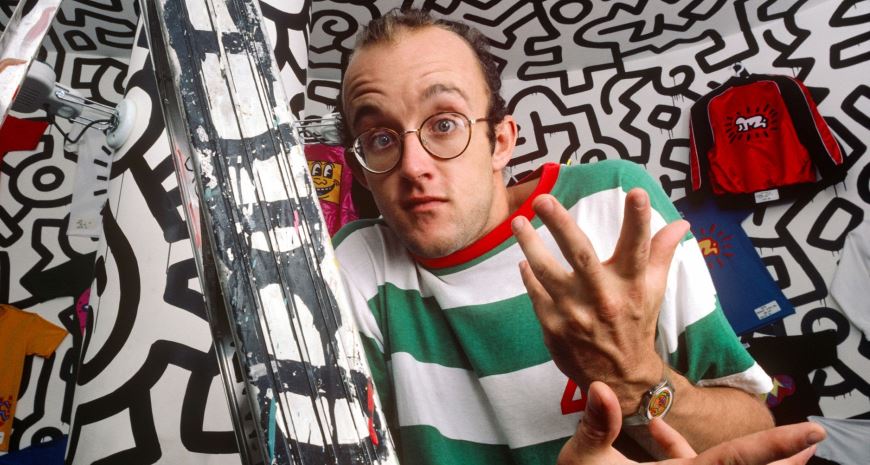An emblematic figure of the New York art scene in the 1980s, Keith Haring is world renowned for the major influence his graffiti-inspired art had on both pop and street art. Artalistic takes you on a deep dive into this artist’s life and work, whose subject matter was focused on activism and the AIDS crisis of the 1980s.
Keith Haring and his inspiring social street art
Born in Pennsylvania, Keith Haring (1958-1990) was fascinated by art from an early age. He began experimenting in art creating humorous collages using newspapers and sketching.
New York & the avant-garde subculture
At the end of the 1970s, after studying advertising in Pittsburgh, Haring enrolled at the School of Visual Arts (SVA) in New York, devoting himself completely to art. Keith Haring quickly became involved in the emerging street art scene and developed an interest in graffiti.
The alternative culture of the 1980's was booming and now-iconic artists like Andy Warhol and Jean-Michel Basquiat were stepping onto the art scene. Keith Haring immersed himself in the punk clubs and street art scene of New York as he began experimenting with different media to create his art.
Later he became interested in hip-hop culture, absorbing the energy and movement of dancers, DJs and graffiti artists. He worked to improve various artistic techniques and his art matured. Haring began using unconventional places as canvases for his art, painting on street walls, over subway advertisements and warehouse facades. He covered these spaces with his figurative yet simple paintings. This era in his artistic career marked the birth of his now-iconic and universally understood hieroglyphic style.
Artistic approach
Keith Haring was socially conscious and his street art often reflected his position on social issues. Haring used simple linework to make minimalist representations that were reminiscent of comics and cartoons. His subjects were extremely stylized, colorful and very expressive.
Trouble with the police
Haring was extremely productive, working endlessly on new projects. He was arrested by the police several times for vandalism. Around this time, he joined Club 57, a New York nightclub and hangout for performance and visual artists and musicians. Keith Haring met countless influential artists of his time, including Andy Warhol who became one of his mentors.
A meteoric rise to fame
Haring’s fame seemed to happen overnight, he was commissioned for countless public projects and had exhibitions in major museums, all the while never losing his passion for creating social street art. He created murals all over the world from Rio de Janeiro to Berlin, Melbourne and countless major cities across America. He even painted a 300-meter-long fresco on the Berlin wall.
As an outspoken social rights activist, Keith Haring was not one to shy away from controversy, creating work that touched on subjects such as racism, violence, homophobia, sex, death, the dangers of capitalism, technology and protecting the environment.
Keith Haring’s belief in bringing art to the masses
Keith Haring famously stated, “Art is nothing if you don’t reach every segment of the people.” This is one of the main reasons why he made the world his canvas, creating art in places that were easily accessible to all people. He worked to spread notions of peace, love and equality in a universal visual language. He used his art to touch on themes that he dreamed of changing.
The many themes of Keith Haring’s socially engaged street art
Keith Haring worked continuously during his short but exciting life to create visually impactful art that was charged with meaning. His paintings and sculptures touched on so many themes that it would be impossible to list them all here. However, the following lists a few of his main subjects:
- Capitalism: Haring was very critical of American consumer culture and the power of money, which he abhorred
- Religion: although he respected an individual’s right to follow a religion, he was opposed to religious control
- Mass media: he feared new technologies and their capacity to take over reality
- Racism: Haring was a firm believer in equality
- Ecology: Haring was also a visionary in this field and feared the negative impact humans have on biodiversity
- Homophobia: Haring was a firm supporter of the LGBTQIA+ community
Sadly, Keith Haring died of AIDS at the young age of 31 in 1990, leaving a lasting legacy of art that would go on to inspire countless artists including Banksy and JR.
Artalistic: A leading platform for buying and selling contemporary art online
If you would like to continue your journey into the world of pop art and social street art, feel free to browse our virtual galleries featuring artworks by well-established and emerging artists.
Artalistic is a highly-acclaimed platform for selling fine art online. We feature a wide range of different media including: paintings, drawings, sculptures, photographs, limited edition prints and much more. Thank you and see you soon for the latest news from the art world!
 English
English Français
Français


You must be logged in to post a comment.
Click here to log in